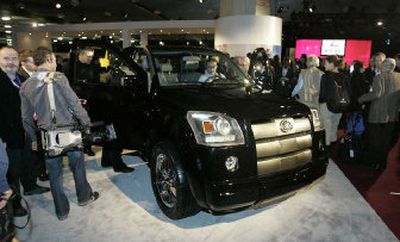Chinese look for inroads

DETROIT — A year ago, a lone Geely Automobile Co. sedan sitting outside the main exhibit halls marked the first time a Chinese automaker displayed at the North American International Auto Show.
This year, Geely was absent from the Detroit show. But another Chinese automaker — Hunan Changfeng Motor Co. Ltd. — was showing its cars in a more polished display, albeit one in a basement exhibit hall.
Changfeng’s Liebao brand cars, including a pair of small sport utility vehicles, are being built for the growing Chinese market. But the company is looking for a way to get them on U.S. roads.
Regardless of whether Geely or Changfeng themselves make the jump, the Chinese auto industry represents a tenacious future competitor in America. Roadblocks remain, such as the cost of getting them here and consumer worries about the quality of Chinese cars, but some observers expect Chinese-built cars to be competing for drivers before the end of the decade.
“One of these days you’re going to see Chinese cars all over the place,” said American entrepreneur Malcolm Bricklin, who brought the Yugo and Subaru to this country and wants to export luxury vehicles from China to the U.S. as soon as 2009.
While the U.S. market likely will be important for Chinese carmakers, surviving in their home market may be a shorter-term focus. Foreign automakers are competing aggressively in China, where sales are expanding at double-digit annual rates and major U.S., European and Asian producers have set up factories.
The industry estimates that vehicle sales in China this year are expected to rise by 15 percent to 8 million, up from an estimated 7 million in 2006, compared with predictions the U.S. sales will be flat to lower after dropping to about 16.5 million in 2006 from just under 17 million in 2005.
Africa, Asia and the Middle East have been major markets for Chinese exports. And Rebecca Lindland, an auto analyst at Global Insight, an economic research and consulting company, said Chinese companies need to balance efforts to satisfy their growing domestic market while looking to expand exports.
“You need to see it as a credible — if long-distance — threat,” Lindland said Monday at the Detroit show. “You just can’t bury your head in the sand.”
Chinese manufacturers face tough logistical issues in bringing vehicles to the U.S., such as establishing dealer and service networks, as well as the cost of bringing them in from afar, Lindland said. The overall cost of importing, she noted, is part of why Japanese and South Korean automakers built plants in the U.S.
Some of those obstacles could be avoided through partnerships with companies that already have a significant share of the U.S. market. And because of that, the first Chinese-made cars for the U.S. might not be sold under Chinese nameplates.
Last month, DaimlerChrysler AG’s Chrysler Group and China’s Chery Automobile Co. announced that they agreed on a plan for the Chinese manufacturer to build small cars to be sold worldwide. They will be sold at Chrysler dealerships including those in the U.S. under the Dodge, Chrysler or Jeep names.
General Motors Corp. and Ford Motor Co. already have significant manufacturing deals with Chinese companies, but they aren’t sold in the U.S. GM Chief Executive Rick Wagoner said it is possible that GM would build a small car in China and import it to the U.S, but the company has no plans to do that at present.
Wagoner said Chinese manufacturers are smart and will be careful not to bring products to the U.S. before they are ready for the market.
“The domestic manufacturers in China are on a steep learning curve,” he said in an interview with a group of reporters last week.
Public perception of Chinese vehicles — and their quality — will be key in how well they are received. People were evenly divided on whether they would consider buying a car from a Chinese manufacturer — 49 percent said yes and 49 percent said no in an AP-AOL Autos poll conducted last month.
Young people are more open to the idea of buying a Chinese car than are older people — 70 percent of those under 35 would consider buying a Chinese car, compared with just 39 percent of those 35 and older.